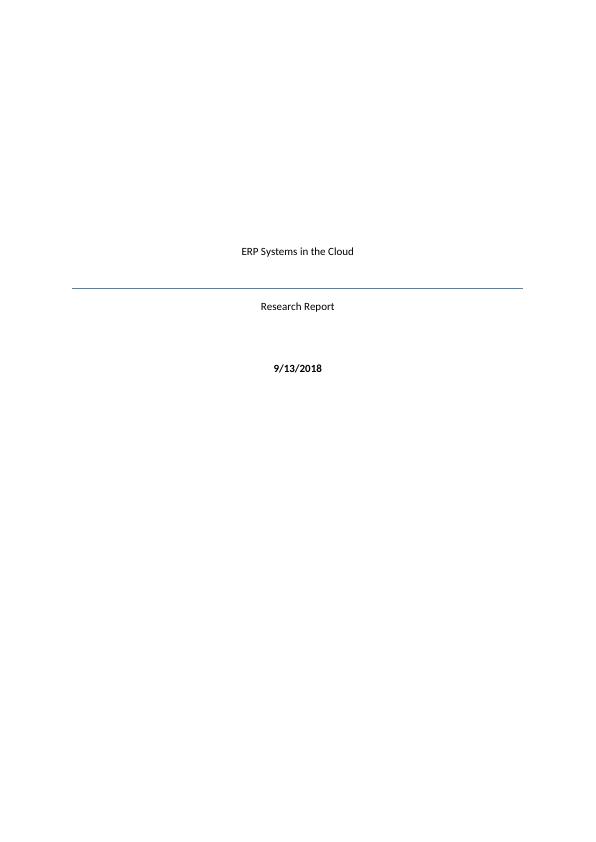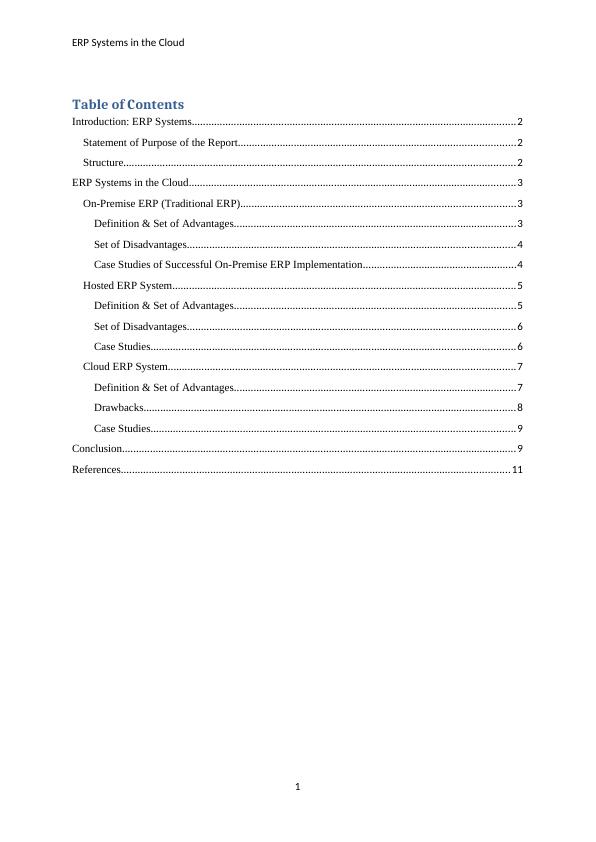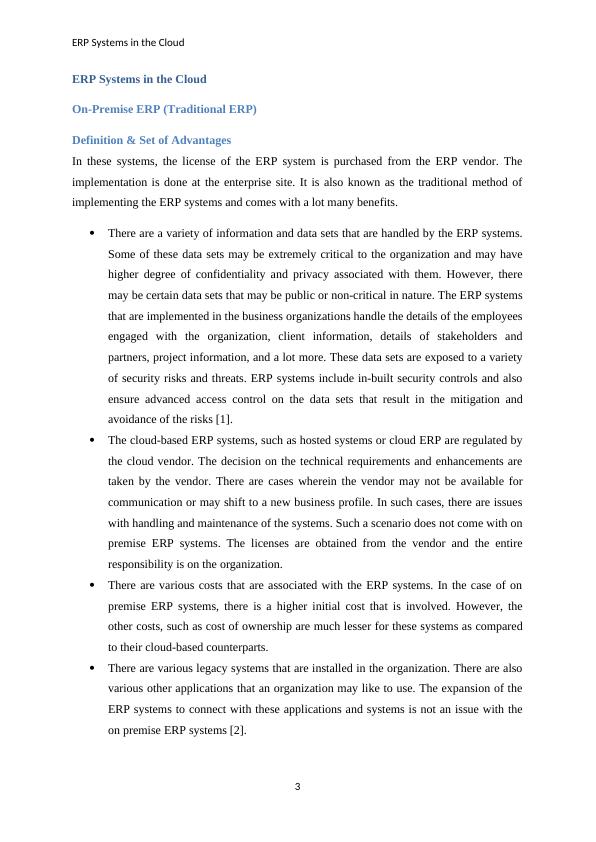ERP Systems in the Cloud: Advantages and Disadvantages
Added on 2023-06-06
12 Pages3891 Words270 Views
ERP Systems in the Cloud
Research Report
9/13/2018
Research Report
9/13/2018

ERP Systems in the Cloud
Table of Contents
Introduction: ERP Systems....................................................................................................................2
Statement of Purpose of the Report...................................................................................................2
Structure............................................................................................................................................2
ERP Systems in the Cloud.....................................................................................................................3
On-Premise ERP (Traditional ERP)..................................................................................................3
Definition & Set of Advantages.....................................................................................................3
Set of Disadvantages.....................................................................................................................4
Case Studies of Successful On-Premise ERP Implementation.......................................................4
Hosted ERP System...........................................................................................................................5
Definition & Set of Advantages.....................................................................................................5
Set of Disadvantages.....................................................................................................................6
Case Studies..................................................................................................................................6
Cloud ERP System............................................................................................................................7
Definition & Set of Advantages.....................................................................................................7
Drawbacks.....................................................................................................................................8
Case Studies..................................................................................................................................9
Conclusion.............................................................................................................................................9
References...........................................................................................................................................11
1
Table of Contents
Introduction: ERP Systems....................................................................................................................2
Statement of Purpose of the Report...................................................................................................2
Structure............................................................................................................................................2
ERP Systems in the Cloud.....................................................................................................................3
On-Premise ERP (Traditional ERP)..................................................................................................3
Definition & Set of Advantages.....................................................................................................3
Set of Disadvantages.....................................................................................................................4
Case Studies of Successful On-Premise ERP Implementation.......................................................4
Hosted ERP System...........................................................................................................................5
Definition & Set of Advantages.....................................................................................................5
Set of Disadvantages.....................................................................................................................6
Case Studies..................................................................................................................................6
Cloud ERP System............................................................................................................................7
Definition & Set of Advantages.....................................................................................................7
Drawbacks.....................................................................................................................................8
Case Studies..................................................................................................................................9
Conclusion.............................................................................................................................................9
References...........................................................................................................................................11
1

ERP Systems in the Cloud
Introduction: ERP Systems
Enterprise Resource Planning (ERP) systems are being used in the business organizations and
have succeeded in providing the enterprises with a lot many benefits. ERP is a software suite
which is configured and installed in the enterprise for the integration of the functions and
technologies at the back-end. The automation of the functions is done as an outcome. Some
of the business operations that are synced in an ERP system include human resource
management, customer relationship management, supplier relationship management,
production processes, manufacturing cycles, and a lot more. There are benefits that have been
experienced with the implementation of ERP systems in the organizations. Some of these
benefits include better collaboration of services, enhanced security of the data sets, improved
flexibility and scalability levels along with faster processing of operations.
There are different methods that can be used to implement the ERP systems. The first is the
traditional approach of implementation in which on premise ERP systems are installed. In
these systems, the license of the ERP system is purchased from the ERP vendor. The
implementation is done at the enterprise site. The other two approaches include cloud
computing as one of the technologies. These are hosted ERP systems and Cloud ERP
systems. These follow the cloud Infrastructure as a Service (IaaS) and cloud Software as a
Service (SaaS) models respectively.
Statement of Purpose of the Report
The report serves the purpose of highlighting the different methods that can be used to
implement the ERP systems in an organization by covering the traditional and cloud-based
approaches.
Structure
The report includes a brief introduction that discusses the meaning and applications of ERP
and provides the purpose and structure details of the report. The three ERP implementation
methods are then discussed in detail and are supported by various case studies. There is a
conclusion that is included at the end of the report.
2
Introduction: ERP Systems
Enterprise Resource Planning (ERP) systems are being used in the business organizations and
have succeeded in providing the enterprises with a lot many benefits. ERP is a software suite
which is configured and installed in the enterprise for the integration of the functions and
technologies at the back-end. The automation of the functions is done as an outcome. Some
of the business operations that are synced in an ERP system include human resource
management, customer relationship management, supplier relationship management,
production processes, manufacturing cycles, and a lot more. There are benefits that have been
experienced with the implementation of ERP systems in the organizations. Some of these
benefits include better collaboration of services, enhanced security of the data sets, improved
flexibility and scalability levels along with faster processing of operations.
There are different methods that can be used to implement the ERP systems. The first is the
traditional approach of implementation in which on premise ERP systems are installed. In
these systems, the license of the ERP system is purchased from the ERP vendor. The
implementation is done at the enterprise site. The other two approaches include cloud
computing as one of the technologies. These are hosted ERP systems and Cloud ERP
systems. These follow the cloud Infrastructure as a Service (IaaS) and cloud Software as a
Service (SaaS) models respectively.
Statement of Purpose of the Report
The report serves the purpose of highlighting the different methods that can be used to
implement the ERP systems in an organization by covering the traditional and cloud-based
approaches.
Structure
The report includes a brief introduction that discusses the meaning and applications of ERP
and provides the purpose and structure details of the report. The three ERP implementation
methods are then discussed in detail and are supported by various case studies. There is a
conclusion that is included at the end of the report.
2

ERP Systems in the Cloud
ERP Systems in the Cloud
On-Premise ERP (Traditional ERP)
Definition & Set of Advantages
In these systems, the license of the ERP system is purchased from the ERP vendor. The
implementation is done at the enterprise site. It is also known as the traditional method of
implementing the ERP systems and comes with a lot many benefits.
There are a variety of information and data sets that are handled by the ERP systems.
Some of these data sets may be extremely critical to the organization and may have
higher degree of confidentiality and privacy associated with them. However, there
may be certain data sets that may be public or non-critical in nature. The ERP systems
that are implemented in the business organizations handle the details of the employees
engaged with the organization, client information, details of stakeholders and
partners, project information, and a lot more. These data sets are exposed to a variety
of security risks and threats. ERP systems include in-built security controls and also
ensure advanced access control on the data sets that result in the mitigation and
avoidance of the risks [1].
The cloud-based ERP systems, such as hosted systems or cloud ERP are regulated by
the cloud vendor. The decision on the technical requirements and enhancements are
taken by the vendor. There are cases wherein the vendor may not be available for
communication or may shift to a new business profile. In such cases, there are issues
with handling and maintenance of the systems. Such a scenario does not come with on
premise ERP systems. The licenses are obtained from the vendor and the entire
responsibility is on the organization.
There are various costs that are associated with the ERP systems. In the case of on
premise ERP systems, there is a higher initial cost that is involved. However, the
other costs, such as cost of ownership are much lesser for these systems as compared
to their cloud-based counterparts.
There are various legacy systems that are installed in the organization. There are also
various other applications that an organization may like to use. The expansion of the
ERP systems to connect with these applications and systems is not an issue with the
on premise ERP systems [2].
3
ERP Systems in the Cloud
On-Premise ERP (Traditional ERP)
Definition & Set of Advantages
In these systems, the license of the ERP system is purchased from the ERP vendor. The
implementation is done at the enterprise site. It is also known as the traditional method of
implementing the ERP systems and comes with a lot many benefits.
There are a variety of information and data sets that are handled by the ERP systems.
Some of these data sets may be extremely critical to the organization and may have
higher degree of confidentiality and privacy associated with them. However, there
may be certain data sets that may be public or non-critical in nature. The ERP systems
that are implemented in the business organizations handle the details of the employees
engaged with the organization, client information, details of stakeholders and
partners, project information, and a lot more. These data sets are exposed to a variety
of security risks and threats. ERP systems include in-built security controls and also
ensure advanced access control on the data sets that result in the mitigation and
avoidance of the risks [1].
The cloud-based ERP systems, such as hosted systems or cloud ERP are regulated by
the cloud vendor. The decision on the technical requirements and enhancements are
taken by the vendor. There are cases wherein the vendor may not be available for
communication or may shift to a new business profile. In such cases, there are issues
with handling and maintenance of the systems. Such a scenario does not come with on
premise ERP systems. The licenses are obtained from the vendor and the entire
responsibility is on the organization.
There are various costs that are associated with the ERP systems. In the case of on
premise ERP systems, there is a higher initial cost that is involved. However, the
other costs, such as cost of ownership are much lesser for these systems as compared
to their cloud-based counterparts.
There are various legacy systems that are installed in the organization. There are also
various other applications that an organization may like to use. The expansion of the
ERP systems to connect with these applications and systems is not an issue with the
on premise ERP systems [2].
3

End of preview
Want to access all the pages? Upload your documents or become a member.
Related Documents
ERP Systems in the Cloud: Features, Benefits, Drawbacks, and Case Studieslg...
|13
|3948
|190
Introduction Enterprise Resourci'on, Risks of Cloud ERP Systemslg...
|14
|4420
|147
Cloud ERP System: Advantages and Disadvantageslg...
|17
|4326
|198
Enterprise Resource Planning (ERP) System - PDFlg...
|12
|3809
|181
Experience of Companies in reinforcing the advantages 6lg...
|19
|4525
|191
CLOUD ERP SYSTEM FOR ENTERPRISES (PDF)lg...
|16
|4278
|19
